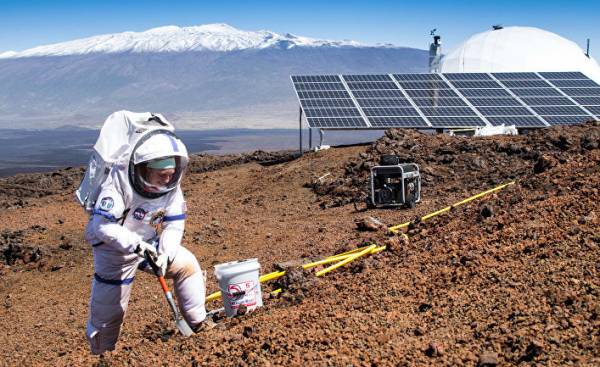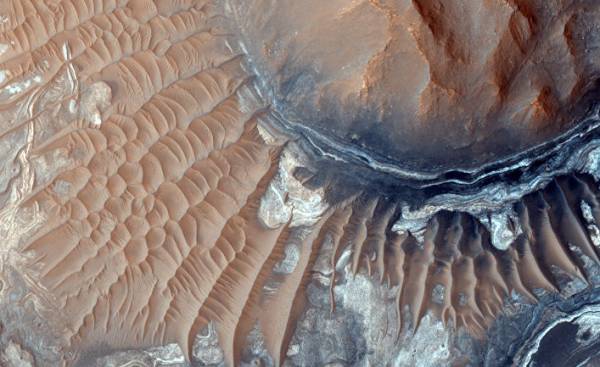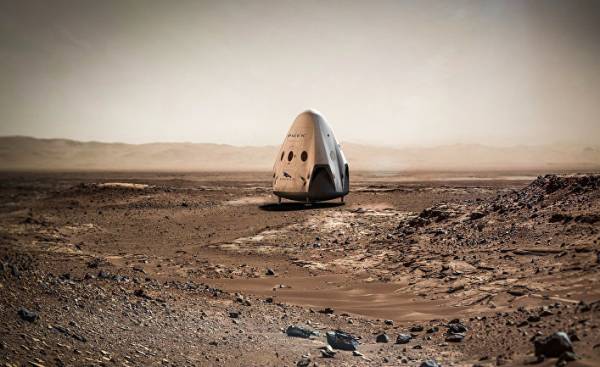
Why people can not go to Mars? Because it’s incredibly expensive, technically difficult, and very risky.
Still, we probably would have gone back at the end of the twentieth century, if Mars was a little more hospitable than the rusty red desert.
But not so long left to wait for the moment when he will begin the biggest adventure of mankind. One of those promoting the project — buzz Aldrin (Buzz Aldrin), an American with Swedish roots who became the second man on the moon. Another enthusiast — Elon Musk (Elon Musk) with its dizzying plans.
NASA plans to launch the first manned journey to Mars in 2030-ies. The conditions for this is due to the huge new SLS rocket and Quad capsule “Orion”. But the private company SpaceX and its active head Elon Musk is going to send people to Mars as early as 2024 with ITS missiles, which will be several times more powerful than SLS, and a moon rocket “Saturn-5”, is generally the coolest, that was created so far.
And this is only the beginning. Musk and Aldrin want to colonize Mars and eventually make the planet more habitable than it is now. The same intent is there and the group pressure of the Mars Society. To find traces of life, which is now high on the list of priorities, but more importantly in the long term, to spread mankind through the Solar system and thereby ensure the survival of the species. The same thoughts and have Fuglesang Christer (Christer Fuglesang is a Swedish physicist and astronaut, first Swedish, approx. TRANS.).
But a significant change in the character of an entire planet, terraforming, yet relates to the field of science fiction. Of course, Mars is much smaller than Earth, but the mass of it is about the same. Very thin atmosphere consists of 95% carbon dioxide. The water immediately evaporates. On the planet very cold, although on the equator the temperature sometimes and crawls to positive values.
A one-way ticket
After some time, Musk wants to send to Mars about a hundred people. This is the journey each way and according to his plan, as conceived by Aldrin. It’s easier, smarter and cheaper than to bring people back to Earth. They will have to learn to live on the inhospitable red planet.
Mars has always attracted people. Werner von Braun (Wernher von Braun), a brilliant German rocket scientist who created the V2, and later missile, which the United States sent to the moon, had serious plans for a flight there in the early 1950’s. It is noteworthy that according to his plan in the first journey was supposed to take 12 people, and Musk says about the same number.
Von Braun argued that the journey to Mars was quite possible even with the technology of the time. With a ruler instead of a computer. Rich in details the book “exploration of Mars” (The Exploration of Mars, 1956), he talks about his grandiose ideas along with loved the theme of space writer Willy Ley (Willy Ley), and Bonstelle Illustrator Chesley (Chesley Bonestell). By the way, his drawings were surprisingly sootvetststvuyuschie reality.
Ley, who fled Nazi Germany in 1935, and Bonsall from San Francisco in 1949 worked together on the book “Conquest of space” (The Conquest Of Space). Both loved science fiction and was convinced that space travel will soon become a reality.
Von Braun was a member of the Nazi party
At least this time he was sure von Braun, who after the Second world war, found refuge in the United States, despite its ugly past. Its missiles claimed the lives of thousands of people and caused massive destruction in England.
Von Braun was a controversial man, a member of the Nazi party and the SS, but was critical of the war. He dreamed about traveling in space. If he hadn’t meant so much for the missile programme of the country, he would have been executed immediately, as soon as he fell out of favor with Hitler.
In 1957 the Soviet Union stunned the world that launched the first Earth satellite. Started the space race. The next step in her von Braun believed the moon, and the ultimate goal is Mars. The same thought and the Russian, who made an unsuccessful attempt to send in the device before it failed US with “Mariner-4”. Flying past Mars in July 1965, the probe sent to Earth the first images of the planet taken from a close distance.
It was a historic achievement, but, unfortunately, black and white pictures were disappointing for both space experts and ordinary people. They showed that on Mars there are craters, just as on the moon. Up to this point, most people believed that Mars is more like Earth, that there will be a thick atmosphere and perhaps primitive life, at least vegetation. Little green men and the channels seemed to have been unlikely.
Interest in Mars has fallen
Later probes found that the pressure on Mars is a hundred times smaller than the earth and the living conditions there are very bad. However, the devices continued to send. In 1971, the Soviet Union became the first, whose unit made a soft landing on the surface, but, unfortunately, the probe worked for about 20 seconds.
1976 was a year of great triumph USA when are very sophisticated machines “Viking-1 and Viking-2” both made a perfect landing on Mars July 20 and September 3, respectively. Their goal was the search for life. Each probe weighed almost 600 pounds and was Packed with laboratory equipment. Manipulators have collected samples of soil for analysis, but no biological activity has not been recorded. Mars seemed sterile.
In this regard, decided that the motive for a manned visit there. Interest in the red planet fell sharply, and unmanned launches had ceased for about two decades. Only with the launch of Mars Pathfinder in 1997, interest again began to gain momentum. Pathfinder landed softly and made a lot of photos, and he was carrying a small radio-controlled machine — the Rover Sojourner.
In 1999, the mission began the station Mars Global Surveyor, which photographed Mars from orbit and performed a variety of measurements. It was a new major breakthrough in the study of Mars, the unit, sent home with more information than all previous together. On Mars turned out to be a lot of very interesting formations, including cleft with a length of 400 km, valley of the Mariner, in comparison with which the Grand Canyon seems a small groove.
 © NASA/JPL/University of ArizonaЛабиринт Night on Mars
© NASA/JPL/University of ArizonaЛабиринт Night on Mars
In 2003, using a Russian rocket went into the way of the European Mars Express. As planned, the probe went into orbit and sent down a landing unit Beagle 2, but it crashed.
Unsuccessful attempt to send a probe
Soon, however, the United States managed to put two small machine Spirit and Oppоrtunity. They traveled to the planet’s surface, took photographs and collected data. Both have been much longer than was calculated.
The Orbiter, Mars Reconnaissance Orbiter and Phoenix lander reached the place in 2006 and 2008 and carried out their tasks. The Orbiter shot potentially suitable for future planting space and the lander took samples of soil from the depth, trying to find frozen water.
In 2012, made a precise landing NASA Curiosity Rover weighs 900 kg as a small car. He traveled on Mars, examine the climate and Geology, made a lot of pictures and tried to find places where there is or could exist microbial life.
Two years later, the Indian probe, Mars Orbiter Mission went into orbit around Mars. Its main task was mainly the study of the atmosphere. A similar task was from the us Maven, which also reached the red planet in 2014.
Mars has not been kind to the guests from Earth. Many probes have failed a mission. For example, the failed Russian interplanetary station “Mars-96”, large-scale project with participation of one Orbiter, two landing modules and two “drillers” that had to penetrate under the surface. The rocket crashed still in earth orbit. European-Russian “ExoMars-2016” in 2016 reached the goal and came out on the right orbit, but its release unit “Schiaparelli” was wrecked.
Many problems
Of course, this should not happen when you go in there people. More and more experts believe in an international project such as space station ISS. Among individual countries is hardly enough funds for this, if only in the near future there will be a sharp technical breakthrough that will make the journey shorter and cheaper. Can Elon Musk really scrape together the huge sum required for the project? Russia has too little money, but China is going to Mars. The question of when.
Buzz Aldrin is developing its own idea of “sykler”, a large space Shuttle, which runs continuously between the Earth and Mars orbit at thoroughly researched, allowing him to continue the journey without refueling. Thought Aldrin, people will go up to the “bus” when he passes by, and then on arrival into place to leave. Thus, each run will be much cheaper than if separate rockets overcame the full path between the planets.
One of the many unsolved problems is how to protect space travelers from harmful radiation, which occurs at the moment of sudden solar flares. Journey to Mars can take up to six months. Another danger is that the astronauts, having spent so much time in space, is so weakened that you will not be able to start working.
 © flickr.com, Racecommittee apparatus Dragon on the surface of Mars
© flickr.com, Racecommittee apparatus Dragon on the surface of Mars
Finally, there is the widely discussed question, how will the first journey. Sit down space ship from Mars or one of its small moons, Phobos or Deimos? Or he never will land, and make a few laps around Mars, and then return to Earth? In this scenario I do not believe. It is unlikely that the people who for many months were in the way, want to just enjoy the views upon arrival.
Mars: chronology of events
1954. Edition of Collier’s has released a special large room: “Can we get to Mars?” (“Can we get to Mars?”). Not later than one hundred years, says Werner von Braun.
1956. In the book “exploration of Mars” (The Mars Exploration av) optimistic von Braun hopes that a manned mission to Mars will take place in a few decades.
1960-1962. Five unsuccessful attempts of the Soviet Union send probes to Mars.
1964. The first attempt to reach Mars failed.
1965. Second, using the “Mariner 4”. Flying past Mars, the probe sent home 21 photograph of the planet.
1971. The Soviet Union managed to send into orbit “Mars-3” and put on the surface of the single module. Unfortunately, he spent only a few seconds. The American “Mariner-9” also went into orbit and made 7329 pictures of Mars, which was much more diverse than previously thought.
1976. The United States managed to successfully land “the Viking-1 and Viking-2”. Probes looking for life, but find nothing.
1988. Two unsuccessful Russian attempts to land on the Mars moon Phobos.
1993. The failure of the mission is damn expensive machine USA Mars Observer.
1996. Large-scale Russian project “Mars-96” has failed. But the American apparatus Mars Global Surveyor got to the place. After numerous problems probe in 1999 began to map the planet.
1997. The success of U.S. soft landing Pathfinder RC with its little Rover Sojourner, which nearly three months have covered the distance up to 100 meters.
1998. Japan failed probe to Mars.







